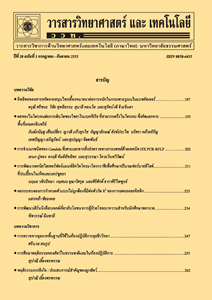ผลของการเคลือบเมล็ดด้วย Metalaxyl, Captan และ Mancozeb หลังผ่านการทำไพรม์มิ่งต่อความงอกและการเจริญเติบโตของต้นกล้าข้าวโพดเลี้ยงสัตว์
Main Article Content
บทคัดย่อ
ข้าวโพดเลี้ยงสัตว์เป็นวัตถุดิบสำคัญสำหรับใช้ในอุตสาหกรรมอาหารสัตว์ จึงมีความต้องการผลผลิตจำนวนมากเพื่อเข้าสู่ระบบอุตสาหกรรมการแปรรูปอาหารสัตว์ แต่ในกระบวนการผลิตยังคงประสบปัญหาของคุณภาพเมล็ดพันธุ์เสื่อมคุณภาพและการเข้าทำลายของราและโรคในระยะต้นกล้า จึงแก้ปัญหาด้วยการใช้เทคโนโลยีด้านการปรับปรุงสภาพเมล็ดพันธุ์มาใช้เพื่อยกระดับคุณภาพเมล็ดพันธุ์ให้ดีขึ้น งานทดลองนี้จึงมีวัตถุประสงค์เพื่อศึกษาการเปลี่ยนแปลงคุณภาพของเมล็ดพันธุ์ข้าวโพดเลี้ยงสัตว์หลังผ่านการไพรม์มิ่งด้วย KNO3 และเคลือบเมล็ดร่วมกับสารเคมีป้องกันราในอัตราที่ต่างกัน โดยมีกรรมวิธีทดลองดังนี้ เมล็ดไม่เคลือบ (T1) การเคลือบเมล็ดด้วยพอลิเมอร์เพียงอย่างเดียว (T2) เมล็ดที่เคลือบด้วย Metalaxyl อัตรา 2, 4 และ 6 g.ai. (T3, T4 และ T5) และเมล็ดที่เคลือบด้วย Captan อัตรา 2, 4 และ 6 g.ai. (T6, T7 และ T8) และเมล็ดที่เคลือบด้วย Mancozeb อัตรา 2, 4 และ 6 g.ai. (T9, T10 และ T11) ดำเนินการทดลองที่ห้องปฏิบัติการเทคโนโลยีเมล็ดพันธุ์ สาขาพืชไร่ คณะผลิตกรรมการเกษตร มหาวิทยาลัยแม่โจ้ โดยมีผลการทดลองดังนี้ การเคลือบเมล็ดด้วย Metalaxyl อัตรา 2, 4 และ 6 g.ai. มีการงอกของราก ความงอกเมื่อตรวจสอบในสภาพห้องปฏิบัติการ และการเจริญเติบโตของต้นกล้าหลังตรวจสอบในสภาพเรือนทดลองดีที่สุดเมื่อเปรียบเทียบกับเมล็ดที่ไม่ได้เคลือบ ส่วนการเคลือบเมล็ดด้วย Captan อัตรา 4 g.ai. มีการงอกของราก ความงอกของเมล็ด ความยาวลำต้นต้นกล้า ความยาวรากเมื่อตรวจสอบในสภาพห้องปฏิบัติการ และเปอร์เซ็นต์การโผล่พ้นดิน ความเร็วในการโผล่พ้นดินของต้นกล้าดีมากกว่าเมล็ดที่ไม่ได้เคลือบเมื่อตรวจสอบในสภาพเรือนทดลอง ส่วนการเคลือบเมล็ดด้วย Mancozeb อัตรา 4 g.ai. ทำให้เมล็ดมีความงอกและความยาวรากของต้นกล้าดีที่สุดเมื่อเปรียบเทียบกับเมล็ดที่ไม่ได้เคลือบและตรวจสอบในสภาพห้องปฏิบัติการ โดยสรุปได้ว่าเมล็ดที่ผ่านการทำไพรม์มิ่งด้วย KNO3 แล้วนำมาเคลือบเมล็ดร่วมกับ Captan อัตรา 4 g.ai. ทำให้เมล็ดมีการงอกราก ความยาวลำต้นต้นกล้า และความยาวรากเมื่อตรวจสอบในสภาพห้องปฏิบัติการ และความงอก ความงอกเร็วในการงอก การโผล่พ้นดิน และความเร็วในการโผล่พ้นดินของต้นกล้าเมื่อตรวจสอบในสภาพเรือนทดลอง ดีที่สุดเมื่อเปรียบเทียบกับเมล็ดที่ไม่ได้ผ่านการเคลือบ
Article Details
เอกสารอ้างอิง
Agricultural Research Development Agency, 2016, Maize, Soybean, Mung Bean and Peanut, Direction of Thai Economic Crops in Asean, Pornsup Printing Co., Ltd., Bangkok. (in Thai)
Suttitham, W., Prempridi, T., Prakobkarn, K., Srichana, D., Panja, P. and Konisranukul, W., 2010, Production of agricultural by-product corn silage, Thai Sci. Technol. J. 18(4): 12-23. (in Thai)
Pedrini, S., Bhalsing, K., Cross, A.T. and Dixon, K.W., 2018, Protocol development tool (PDT) for seed encrusting and pelleting, Seed Sci. Tech. 46: 393-405.
Bradford, K.J., Steiner, J.J. and Trawatha, S.E., 1990, Seed priming influence and emergence of pepper seed lots, Crop Sci. 30: 718-721.
McDonald, M.B., 2000, Seed Priming, pp. 287-325, In Black, M. and Bewley, J.D. (Eds.), Seed Technology and Its Biological Basis, Sheffield Academic Press, Sheffield, England.
Siri, B., 2015, Seed Conditioning and Seed Enhancements, Klungnanawitthaya Priting, Khon Kaen, 239 p. (in Thai)
Taylor, A.G., Allen, P.S., Bennett, M.A., Bradford, K.J., Burris, J.S. and Misra, M.K., 1998, Seed enhancements, Seed Sci. Res. 8: 245-256.
Pedrini, S., Merritt, D.J., Stevens, J. and Dixon, K., 2017, Seed coating: Science or marketing spin?, Trends Plant Sci. 22: 106-116.
Flexer, J. and Belnavis, D., 2000, Microbial Insecticides, pp. 35-62. In Rechcigl, J.E. and Rechcigl, N.A. (Eds.), Biological and Biotechnological Control of Insect Pest, Lewis Publishers, Boca Raton, FA.
Inglis, G.D., Goettel, M.S., Butt, T.M. and Strasser, H., 2006, Use of Hyphomycetous Fungi for Managing Insect Pests, pp. 23-70. In Butt, T.M., Janckson, C. and Magan, N. (Eds.), Fungi as Biocontrol Agents Progress, Problems and Potential, CABI Publishing, London.
ISTA, 2013, International Rules for Seed Testing, ISTA, Bassersdorf.
Theerakulpisut, P., 1997, Plant Physiology, Department of Biology, Faculty of Science, Khon Kaen University, Khon Kaen. (in Thai)
Bunnag, S., 1999, Introduction to Plant Physiology, Department of Biology, Faculty of Science, Khon Kaen University, Khon Kaen. (in Thai)
Dhiumkhunthod, O., 2013, Effect of Moisture and Different Chemical Application by Seed Priming Method on Quality Changes and Longevity of Hybrid Tomato Seeds, Master Thesis, Khon Kaen University, Khon Kaen. (in Thai)
Barker, A.V. and Pilbeam, D.J., 2007, Handbook of Plant Nutrition, Taylor & Francis, Boca Raton.
Kaewnaree, P., 2010, The Biological Changes During an Accelerated Aging and Priming Processes in Sweet Pepper (Capsicum annuum L.) Seeds, Doctoral Dissertation, Khon Kaen University, Khon Kaen.
Kaewnaree, P., Vichitphan, S., Vichitphan, K., Siri, B. and Klanrit, P., 2011, Effect of accelerate aging process on seed quality and biochemical changes in sweet pepper (Capsicum annuum Linn.) seeds, Biotechnology 10: 1682-296.
Krainart, C., Siri, B. and Vichitphan, K., 2015, Effects of accelerated aging and subsequent priming quality and biochemical change of hybrid cucumber (Cucumis sativa Linn.) seeds, J. Agric. Technol. 11(1): 165-179.
Ek-Amnuay, P., 2007, Plant Diseases and Insect Pests of Economic Crops, Siam Insect Zoo, Chiang Mai, 379 p. (in Thai)
Keawkham, T., Siri, B. and Hynes, R.K., 2014, Effect of polymer seed coating and seed dressing with pesticides on seed quality and storability of hybrid cucumber, AJCS 8: 1415-1420.
van Iersel, M.W. and Bugbee, B., 1996, Phytotoxic effects of fungicides on bedding plants, J. Am. Soc. Hort. Sci. 121: 1095-1102.
Moros, J., Armenta, S., Garrigues, S. and Guardia, M., 2007, Comparison of two vibrational procedures for the direct determination of Mancozeb in agrochemicals, Talanta 72: 72-79.
Anitha, S.R. and Savitha, G., 2015, Impact of mancozeb stress on seedling growth, seed germination, chlorophyll and phenolic contents of rice cultivars, Int. J. Sci. Res. 4: 292-296.


